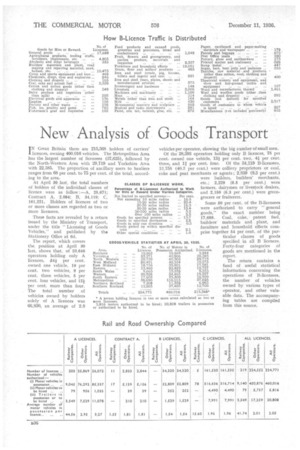New. Analysis of Goods Transport
Page 54

If you've noticed an error in this article please click here to report it so we can fix it.
I N Great Britain there are 215,368 . holders of carriers' licences, owning 460,016 vehicles. The Metropolitan Area has the largest number of licensees (37,625), followed by the North-Western Area with 29,719 and Yorkshire Area with 22,385. The proportion of ancillary users to hauliers ranges from 68 per cent. to 75 per cent. of the total, according to the area.
At April 30 last, the total numbers of holders of the individual classes of licence were as follow :-A, 25,671; Contract A, 2,084: B, 34,119; C, 161,221. Holders of licences of two or more classes are regarded as two or more licensees.
These facts are revealed by a return issued by the Ministry of Transport, under the title " Licensing of Goods Vehicles," and published by thai Stationery Office at fid.
The report, which covers tbe, position at April 30 last, shows that, of 23,646 operators holding only A licences, 544 per cent. owned one vehicle, 19 per cent, two vehicles, s per cent, three vehicles, 5 per cent, four vehicles, and 124 per cent, more than four. The total number of vehicles owned by holders solely of A. licences was 66,830, an average of 2.8
vehicles per operator, showing the big number of small men. Of the 28,393 operators holding only B licences, 78 per cent.owned one vehicle, 134 per cent. two, 44 per cent.
three, and 14 per cent. four. Of the 34,119 B-licensees, 13,158 (40.3 per cent.) were colliery proprietors or coal, coke and peat merchants or agents ; 2,839 (8.3 per cent) were builders, builders' merchants, etc.; 2,229 (6.5 per cent,) were farmers, dairymen or livestock dealers, and 2,150 (6.3 per cent.) were greengrocers or fruiterers.
Some 50 per cent. of the B-licensees were authorized to carry " general goods," the exact number being 17,689. Coal, coke, patent fuel, builders materials and plant, and furniture and household effects comprise together 54 per cent. of the particular classes of goods specified in all B licences. Forty-four categories of goods are mentioned in the report.
The return contains a fund of useful statistical information concerning the operations of B-Iicensees, the number of vehicles owned by various types of operator, and other valuable data. The accompanying tables are compiled from this source.




































































































